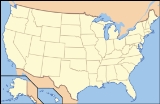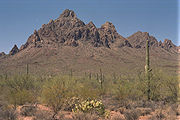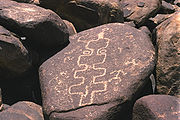
Ironwood Forest National Monument
Encyclopedia


Sonoran Desert
The Sonoran Desert is a North American desert which straddles part of the United States-Mexico border and covers large parts of the U.S. states of Arizona and California and the northwest Mexican states of Sonora, Baja California, and Baja California Sur. It is one of the largest and hottest...
and the U.S. state
U.S. state
A U.S. state is any one of the 50 federated states of the United States of America that share sovereignty with the federal government. Because of this shared sovereignty, an American is a citizen both of the federal entity and of his or her state of domicile. Four states use the official title of...
of Arizona
Arizona
Arizona ; is a state located in the southwestern region of the United States. It is also part of the western United States and the mountain west. The capital and largest city is Phoenix...
. Created by Bill Clinton by Presidential Proclamation 7320 on June 9, 2000, the 129,022 acre (522 km2) monument is managed by the U.S. Bureau of Land Management, an agency within the U.S. Department of the Interior. Although the National Monument status applies only to federal lands, the monument perimeter surrounds about 189000 acres (765 km²) contiguous of federal and private land holdings, including Arizona State School Trust lands.
A significant concentration of Ironwood
Ironwood
Ironwood is a common name for a large number of woods that have a reputation for hardness. Usage of the name may include the tree that yields this wood...
(also known as Desert Ironwood, Olneya tesota
Olneya tesota
Olneya tesota is a perennial flowering tree of the Fabaceae family, legumes , which is commonly known as Ironwood or Desert Ironwood. It is the only species in the monotypic genus Olneya...
) trees is found in the monument, along with two federally recognized endangered
Endangered species
An endangered species is a population of organisms which is at risk of becoming extinct because it is either few in numbers, or threatened by changing environmental or predation parameters...
animal and plant species. More than 200 Hohokam
Hohokam
Hohokam is one of the four major prehistoric archaeological Oasisamerica traditions of what is now the American Southwest. Many local residents put the accent on the first syllable . Variant spellings in current, official usage include Hobokam, Huhugam and Huhukam...
and Paleoindian archaeological sites have been identified in the monument, dated between 600 and 1450.
Flora
An array of flora are present in the Ironwood Forest National Monument. The higher elevations have the Pinyon-juniper woodlandPinyon-juniper woodland
A Pinyon-juniper woodland is a forest type characteristic of many parts the Western United States, often in higher elevations of desert ecoregions.-Locations:...
plant community. The lower elevations are in the Sonoran Desert ecoregion
Ecoregion
An ecoregion , sometimes called a bioregion, is an ecologically and geographically defined area that is smaller than an ecozone and larger than an ecosystem. Ecoregions cover relatively large areas of land or water, and contain characteristic, geographically distinct assemblages of natural...
. One of the notable trees native here is the Elephant tree, Bursera microphylla
Bursera microphylla
Bursera microphylla, known by the common name Elephant Tree, is a tree in genus Bursera. It grows into a distinctive sculptural form, with a trunk resembling that of an elephant. The Elephant Tree is quite rare...
. Small populations of the endangered Nichols Turk's Head Cactus, although not found among Ironwood trees, occur in very localized limestone-rich areas within the Monument.
Ironwood Trees
The Desert IronwoodOlneya tesota
Olneya tesota is a perennial flowering tree of the Fabaceae family, legumes , which is commonly known as Ironwood or Desert Ironwood. It is the only species in the monotypic genus Olneya...
(Olneya tesota) is a very long-lived tree, with some specimens estimated to be more than 800 years old. Desert Ironwood is a keystone species
Keystone species
A keystone species is a species that has a disproportionately large effect on its environment relative to its abundance. Such species play a critical role in maintaining the structure of an ecological community, affecting many other organisms in an ecosystem and helping to determine the types and...
because it provides a nursery environment
Nurse tree
A nurse tree is a larger, faster-growing tree that shelters a smaller, slower-growing tree or plant. The nurse tree can provide shade, shelter from wind, or protection from animals who would feed on the smaller plant....
of shade and protection that enables young seedlings of other species to become established despite the harsh desert climate, where night-time low temperatures can exceed 105 °F (40.6 °C). The Ironwood also provides shade and roosting area habitat
Habitat
* Habitat , a place where a species lives and grows*Human habitat, a place where humans live, work or play** Space habitat, a space station intended as a permanent settlement...
s for birds. Its smoky lavender-colored blossoms provide nectar for bees and other insects, as well as forage
Forage
Forage is plant material eaten by grazing livestock.Historically the term forage has meant only plants eaten by the animals directly as pasture, crop residue, or immature cereal crops, but it is also used more loosely to include similar plants cut for fodder and carried to the animals, especially...
for animals. The blossoms produce bean pods which also provide food for desert animals.
Prehistoric ecology
Lists of dominant plants in the prehistoric ecologyEcology
Ecology is the scientific study of the relations that living organisms have with respect to each other and their natural environment. Variables of interest to ecologists include the composition, distribution, amount , number, and changing states of organisms within and among ecosystems...
and plant community of the Waterman Mountains
Waterman Mountains
The Waterman Mountains are a low mountainous landform in Pima County, United States. Numerous flora and fauna species are found in the Waterman Mountains, in the Pinyon-juniper woodland plant community. Notable among the tree species is the Elephant tree which species exhibits a contorted...
area in the monument have been published in a sequence that currently dates back to the last glacial period, the Late Wisconsin glatial
Glacier
A glacier is a large persistent body of ice that forms where the accumulation of snow exceeds its ablation over many years, often centuries. At least 0.1 km² in area and 50 m thick, but often much larger, a glacier slowly deforms and flows due to stresses induced by its weight...
period. Dominant trees of that era, based upon pollen records, were Utah Juniper (Juniperus osteosperma), Single-leaf Pinyon
Single-leaf Pinyon
The Single-leaf Pinyon, ', is a pine in the pinyon pine group, native to the United States and northwest Mexico. The range is in southernmost Idaho, western Utah, Arizona, southwest New Mexico, Nevada, eastern and southern California and northern Baja California.It occurs at moderate altitudes from...
(Pinus monophylla), and Redberry Juniper (Juniperus pinchotii), and understory plants included Monardella arizonica
Monardella arizonica
Monardella arizonica is a plant species endemic to Arizona in the USA. Plants within the genus are commonly known as wildmint, coyote mint or monardella.-Ancient history:...
.
Fauna
According to Proclamation 7320, 674 plant and animal species have been identified in the Silverbell MountainsSilver Bell Mountains
The Silver Bell Mountains are an arid north-northwest x southeast trending small mountain range in north-central Pima County, Arizona. The range lies west of Marana, Arizona, located on Interstate-10, northwest of Tucson....
within the monument, including 64 species of mammals and 57 species of birds, although the Bureau of Land Management has been unable to verify those claims. Recent studies by the Arizona-Sonora Desert Museum
Arizona-Sonora Desert Museum
The Arizona-Sonora Desert Museum is a museum and zoo founded in 1952 and located in Tucson, Arizona. It contains a museum and two miles of walking paths on of this property, and is one of the most visited attractions in Tucson...
, however, have documented 560 plant species. Resident birdwatchers have documented more than 80 species of migratory and non-migratory birds.
One specimen of the endangered Lesser Long-nosed Bat
Lesser Long-nosed Bat
The Lesser Long-nosed Bat is a medium-sized bat found in El Salvador, Guatemala, Honduras, Mexico and the United States...
(Leptonycteris curasoae) and a night roost were documented within the monument by bat researchers Karen Krebbs and Yar Petryszyn. They concluded that while the monument may be an important feeding stopover during spring migrations, the presence of L. curasoae in the monument is probably low or incidental.Leptonycteris curasoae is one of only a few bat species that migrate long distances, coming from as far south as Jalisco, Mexico, more than 1600 miles (2,574.9 km).
The Arizona Desert Bighorn Sheep
Desert Bighorn Sheep
The Desert Bighorn Sheep is a subspecies of Bighorn Sheep that occurs in the desert Southwest regions of the United States and in the northern regions of Mexico. The trinomial of this species commemorates the American naturalist Edward William Nelson...
herd located within the monument is the last remaining relict
Relict
A relict is a surviving remnant of a natural phenomenon.* In biology a relict is an organism that at an earlier time was abundant in a large area but now occurs at only one or a few small areas....
population of desert bighorn sheep in southeastern Arizona, having first migrated into North America during the Pleistocene
Pleistocene
The Pleistocene is the epoch from 2,588,000 to 11,700 years BP that spans the world's recent period of repeated glaciations. The name pleistocene is derived from the Greek and ....
epoch. One or two specimens of the Cactus Ferruginous Pygmy Owl
Ferruginous Pygmy Owl
The Ferruginous Pygmy Owl is a small owl that breeds in south-central Arizona in the USA, south through to Mexico, Central America and South America to Bolivia and Argentina. Trinidad, as well as other localities, have endemic subspecies of this owl...
, which was listed as an endangered species in March 1997 and delisted by court order April 14, 2006, have been found within and near the monument by licensed surveyors.
History
The HohokamHohokam
Hohokam is one of the four major prehistoric archaeological Oasisamerica traditions of what is now the American Southwest. Many local residents put the accent on the first syllable . Variant spellings in current, official usage include Hobokam, Huhugam and Huhukam...
people were the first miners in the area. They mined andesite
Andesite
Andesite is an extrusive igneous, volcanic rock, of intermediate composition, with aphanitic to porphyritic texture. In a general sense, it is the intermediate type between basalt and dacite. The mineral assemblage is typically dominated by plagioclase plus pyroxene and/or hornblende. Magnetite,...
, which was useful for making agave
Agave
Agave is a genus of monocots. The plants are perennial, but each rosette flowers once and then dies ; they are commonly known as the century plant....
knives. Andesite knives that originated from Hohokham mines within the monument perimeter have been found as far south as the Sea of Cortez in Mexico.
Silver
Silver
Silver is a metallic chemical element with the chemical symbol Ag and atomic number 47. A soft, white, lustrous transition metal, it has the highest electrical conductivity of any element and the highest thermal conductivity of any metal...
and copper
Copper
Copper is a chemical element with the symbol Cu and atomic number 29. It is a ductile metal with very high thermal and electrical conductivity. Pure copper is soft and malleable; an exposed surface has a reddish-orange tarnish...
mining began in the Silverbell Mountains around 1850 and continues today. Bighorn sheep ewes prefer mine tailings for lambing grounds because the high, steep and open terrain enables them to see and escape from predators.
Activities
The Ironwood Forest National Monument is managed for multiple uses including recreation, cattle grazing and mining, although new mining claims and motorized off-road travel are prohibited by the establishing Proclamation. Livestock grazing, which has occurred continuously for at least the last 125 years within the monument, is currently managed at very light or conservative levels of approximately one cow per every 300 to 400 acres (1.6 km²). Domestic sheep and goats are prohibited as a protection to the bighorn sheep. The Monument offers almost no surface water but contains sufficient groundwater resources.The cattle ranchers maintain more than 80 individual man-made water sources within the monument, in addition to the 14 water sources maintained by the Arizona Game and Fish Department and the Arizona Desert Bighorn Sheep Society. The presence of human-supplied water supports the exceptional abundance of birds, mule deer, coyotes, foxes, bobcats, mountain lions and other wildlife found in the monument.
External links
- Friends of Ironwood Forest, a nonprofit organization partnering with BLM to protect Ironwood Forest National Monument by providing volunteer service, advocacy, and visitor education.
- Arizona Desert Bighorn Sheep Society, a nonprofit organization committed to increasing bighorn sheep populations in Arizona
----

